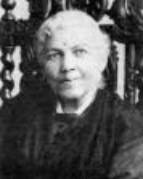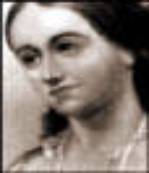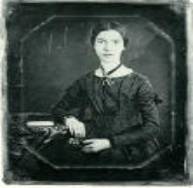
Sample Student Research Project, fall 2004
LITR
4232: American Renaissance

Sample Student Research Project, fall 2004
Elizabeth Davis
November 15, 2004
Women of the American Renaissance
Women have come along way through out history. Women have had to fight their way to the freedom they we now all enjoy. It took many years and many trials and terror for women to gain a voice in this world. Someone had to lead the way to more freedom. Their have been many influential women of the American renaissance that helped pave the way for women. Women of the American Renaissance suggest something sublime, romantic, and gothic about the dream of civil rights for women. These women endured anything and everything they had to gain equal rights. They wanted their voices heard so that all women in America would have their voices heard and change would occur.
The women of the American Renaissance can be described as some what sublime. The mission to be free and have equal rights in essence is beautiful and an admirable goal. The threat it posed upon the women to gain equal rights was somewhat tragic. Women like Harriet Jacobs endured daily harassment as a slave. Emily Dickinson lived most of her life in her room. She seemed to be afraid of what the outside world held. Dickinson seemed to be afraid of what the world represented life, death, love.
Women of the American renaissance possessed a romantic element in their journey for equal rights for women. These women illustrated their longing for change in their writing and they way they lived their lives. Harriet Beecher Stowe and her sister spent their lives trying to develop more opportunities in education for women. Stowe adopted the position as an abolitionist. “Slavery and abolition were abstract and moral issues for Stowe” (Pg. 2476). Writers like Emily Dickinson took a different approach to leading the revolution. Emily Dickinson is somewhat of a mystery no one knows the real truth about her love life. What is evident is that she experienced quite a bit of grief. Her poetry reflects her pain and anguish that she experienced in her life. “Her poems and her letters reveal a passionate, witty woman and a scrupulous craftsman who made an art not only of her poetry but also of her correspondence and her life” (Britannica).
The element of gothic exists with the women of American renaissance and is reflected in their writing. Writers like Jacobs, wrote about her life in slavery and how she spent years trying to gain her freedom. Her personal narrative is surrounded by Gothicism. Jacobs having to live in an attic to hide from her master is a very gothic image. Most attics are either cold or hot and primarily dark. Photographs of these women are in fact gothic. Each woman sits very distinguished with out so much of a smile. It gives them a sense of mystery and disturbance.

Harriet
Beecher Stowe
1811-1896
Harriet Beecher Stowe was apart of a big movement in America. She was a member of a wonderful family. Daughter of Minister Lyman Beecher and sister of Catherine who ran a school for women in Hartford Ct. Stowe’s sister drove the way for the movement of women in education. Stowe’s husband was a prominent theologian. As an Abolitionist her writing of Uncle Tom’s Cabin became one of her greatest works. The first year it sold 300,000 copies “The book exerted an influence equaled by few other novels in history, helping to solidify both pro-and antislavery sentiment” (Britannica). This book was so influential that it was denounced in the south. In the south it became dangerous for people to possess this book. Harriet Beecher Stowe is a role model and pioneer of the American renaissance. Her literature and her family helped advocate her cause as an abolitionist.

Harriet
Ann Jacobs
1813-1897
Harriet Ann Jacobs is a distinguished woman of American renaissance. Through her personal narrative Incidents in the Life of a Slave Girl: Seven Years Concealed, she revealed the trails and tribulations she endured during her time as a slave. Jacobs was subjected to not only to the harassment of just being a slave, but also as a woman. Dr. Norcom her master made her life miserable by sexually harassing her and trying to force her into becoming his concubine. Jacobs however did have a freed grandmother who helped her get away from the clutches of Dr. Norcom. Jacobs in fear of her life was forced to live in the attic above her grandmother’s home. She had to live there while her children where raised by her grandmother. The very character of Harriet Ann Jacobs suggests elements of sublime, romanticism, and gothic. Jacobs in the beginning of her life accepted her life she was a slave. She realized that she had more self respect for herself and was not going to let herself be harassed sexually or mentally. The sublime element in her is her beautiful dream to be free and be able to raise all her children. Who incidentally gave her an even bigger reason to strive for freedom. It was a dangerous journey to achieve her freedom she risked her life and the lives of her children. All she wanted was to say “I am free”. She romanticizes about her freedom and what it would be like. Jacobs’s personal narrative opened the eyes of America to the sexual exploitation of female slaves. She sacrificed total freedom for seven years to have her dream of freedom.

Sarah
Margaret Fuller
1810-1850
Sara Margaret Fuller learned a variety of life lessons and was educated at a very young age. She was a writer, a critic, and an advocate of social reform. Her creation of Woman in the nineteenth century was a direct reflection of her life growing up with her father. Her father was a prominent man and basically gave her all the privileges he would have given a boy. He gave her an exceptional education and a future in the world of American literature. She socialized with well known transcendentalists, Emerson, Thoreau. As stated in the text “Thomas Carlyle called a “Predetermination to eat this big universe as her oyster or her egg, and she made and instant impression on those around her” (Pg. 1626). Her hope was for equality of men and women. Fuller wanted women and men to be treated the same. She wanted to delete the stereotype that women of this time lived by. “Fullers arguments for full equality of opportunity , for abolishing stereotyped gender roles –“ There is no wholly masculine man,” she wrote, “No purely feminine woman”- and for women themselves to represent their own best interests may sound strikingly apt to today’s readers” (Pg. 1627). Fuller wanted to address that we are all people equal people.

Emily
Dickinson
1830-1886
Emily Dickinson was a great poet
a very sensitive poet. As a child
she was outgoing but as years went she regressed and became a recluse. She came
from a prominent family in Amherst, Massachusetts. Dickinson was not like most
women of this time. She never married, and stayed close to home. Her life can be
described as somewhat romantic. Through her poetry she expressed her experiences
with love, life and death. She wrote very beautiful poems about love, which gave
speculations into her maybe having great love affairs. Her poems of death were
expressive of her encounters with death and the inevitability of death. She
possessed a romantic factor through her love poems and apparent love affairs.
She had a mysterious way about her with her seclusion and all white clothing.
She represented Gothicism as well the image of living your life alone in a room
is eerie and some what tragic. She represent sublime with poetry of death the
image of death is terrible but, her expression in her poetry is beautiful. She
pushed the world as far away from her as she could, and could only romanticize
about what it was like on the outside. In her time she was a modern day rebel in
her last 20 years. She rarely left the house and wrote poetry, poetry that is
now frequent in the modern day classroom. This
is my letter to the world / That never wrote to Me- / That simple News that
Nature told- / With tender Majesty
Works Cited
“Dickinson, Emily”.
Encyclopedia Britannica. 2004. Encyclopedia Britannica Premium Service 18 Nov. 2004 <http://www.britannica.com/eb/article?tocId=9030338
“Fuller, Margaret Sara”.
Encyclopedia Britannica. 2004 Encyclopedia Britannica Premium Service 18 Nov.
2004 http://www.britannica.com/eb/article?tocId=9035633>.
“Jacobs, Ann Harriet”.
Encyclopedia Britannica 2004. Encyclopedia Britannica Premium Service 18 Nov.
2004 <http://www.britannica.com/eb/article?tocId=9124987>.
Lauter, Paul. The Heath
Anthology of American Literature. Houghton Mifflin Company: New York. Copyright
2002.
“Stowe, Beecher Harriet”.
Encyclopedia Britannica. 2004. Encyclopedia Britannica Premium Service 18
Nov.2004http://www.britannica.com/eb/article?tocId=9069861>.